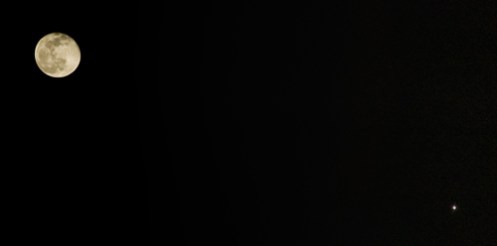Conjunction of The Moon and Jupiter
Two days ago, the almost full moon had a meeting with Jupiter. And I was there to take a group photo of them.
The top left is (of course) our Moon. Bottom right is Jupiter. Click photo to enlarge. Credit: thChieh.
This picture is a composite of two pictures – one exposed for the Moon and the other exposed for Jupiter. It is impossible to get this picture in one shot, because the Moon is too bright and Jupiter is too dim (relatively speaking; Jupiter by itself is consider very bright). If the picture is exposed correctly for the Moon (meaning with a fast shuttle speed), then Jupiter will not show up. If exposed correct for Jupiter (meaning with a slow shuttle speed), then the Moon will be over-exposed. So we need a composite to get the best of both worlds.
After I took the picture and looked at Jupiter in the camera screen, I felt very unsatisfied. Jupiter was not a nice round dot. It was oval. Camera shake? Maybe. I took it again. And again. Still the same oval shape. Maybe the tripod is OK but Jupiter had drifted when the picture is taken? I don’t think so – the exposure time is just 1 second or less and the zoom is not that big (125 mm focal length). I give up on trying to understand why and go back into the house.
I loaded the images into my computer and when I opened the files, voila! Mystery solved! THE MOONS! Jupiter’s moons blended together with the planet and make the “dot” oval. I can’t believe it. I never realised that Jupiter’s moons can be so easily captured. Just a camera plus a 18-135 mm lens* plus a tripod were all that you need! I fired up Stellarium to check on the positions of the moons, and yes, they were where they were supposed to be.
Look carefully at Jupiter at the bigger version picture; you may be able to see its moons – two above (Callisto & Ganymede) and two below (Io & Europa). I cropped it out as below, just in case you are having trouble seeing it. The quality may not be spectacular, but still, to be able to capture the moons is something that I’ve never think of just by using an off-the-shelf camera.
Comparison of Jupiter taken with Nikon D70, 18-135 mm lens with Stellarium.
Later, I went out again…
The Moon had moved to the east a day later, so it was now below and farther away from Jupiter.
~~~~~
*If you are wondering why I’m using 125 mm focal length instead of 135 mm that the lens can offer, the answer is I don’t know. I actually set it to 135 mm, but I think maybe the lens slid back a bit due to gravity when I pointed the camera to the sky. A lesson learned here is that I may need to secure the lens to prevent any movement. What I can think of now is using a (or a few) rubber band.






nice, capture a picture of Jupiter together with the galilean moon with camera is amazing!